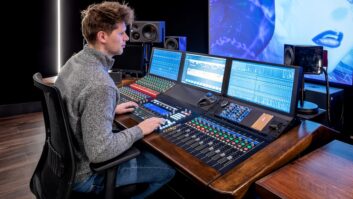
There you are: relaxing in that nice, ergonomically correct chair that’s perfectly situated front and center of your console, completely protected from the harsh conditions of the world outside. When you stop and think about technical field crews—those poor camera guys and recordists who have to bear the cold, the wind, the stormy seas of demanding location shoots—you’ve got to feel bad for them.
Then you fire up your system and check out the raw audio you’ll have to mix, and without leaving your seat, you’ve been thrust right along side of them—into the inhospitable realities of the field and the sounds that accompany it. But the truth is, it works out pretty well for you, considering that audio in need of help equals clients in your studio. On the other hand, there are some fixes that seem to require a little more than even your miraculous powers can handle.
What’s a sound designer/mixer to do? This month, we highlight the strategies and tricks that two veteran audio post engineers use to survive.
Audio post engineer Dallas Taylor of Defacto Sound
Survival Tip #1: Expect Hindrances. . . No Matter What
You know as well as anyone that crews on some shoots are better than others, and budgets on some projects are bigger than others. Both make a marked difference in the quality of audio that results. However, even if you’re fortunate enough to land a project with a budget that afforded a location audio guy, inevitably, there is going to be something to clean up in audio post. “I’m really lucky to be able to work with some very talented and experienced location crews, but even though a good portion of what I receive may sound fine, I still have to process it and make some adjustments,” says audio post engineer Dallas Taylor of Defacto Sound. “Rarely is there not a need for noise reduction or some type of treatment,” says Taylor, who works on a cross-section of projects, including programs appearing on NBC, Fox, the Discovery Channel, A&E, the History Channel, and many more.
Although the most common issue Taylor must contend with in most of his projects is excessive broadband noise, many documentaries require more extensive treatment, especially given the physical environments in which they are being shot. Take, for instance, the Discovery Channel hit show Deadliest Catch. “The situation with Catch is pretty unique in that space is limited, the lodging areas are very small, and there are obviously a number of safety issues that are involved with shooting, so there can be no audio techs on board,” explains Emmy-winning re-recording mixer and sound designer Bob Bronow, who has been working on the show since its inception. “Imagine a sound guy trying to hold a boom pole on a deck covered with six inches of ice. That’s not going to work, so camera operators and producers are the ones responsible for obtaining audio,” adds Bronow, who splits his time between his work at Max Post and his independent company, Audio Cocktail.
The audio captured on Deadliest Catch is done so mainly through camera mics, as well as some lavaliers that have been placed on willing fishermen. Another great example of a program that required significant noise reduction is the former reality show Monster Garage, which featured participants using copious amounts of power tools to fabricate “monster” machines. “With the steady grinding of power tools and constant whirring of engines all within the confines of a large concrete box, the show was my first foray into hostile recording environments,” recalls Bronow, who now works on such programs as Spike TV’s 1,000 Ways to Die, the History Channel’s Ax Men, and films such as The Wrecking Crew. “A camera guy would be asking one of the stars on Monster a question, when all of a sudden he’d fire up a power tool as he was answering.” What resulted was an “interesting” collection of audio that required some serious magic to fix.
Re-recording mixer and sound designer Bob Bronow is pictured at work on the Discovery Channel’s The Deadliest Catch.
Survival Tip #2: Keep Heavy Duty Tools Handy
Pro mixers rely
on myriad noise-reduction tools. For Bronow, the go-to software is the
iZotope RX suite, which enables him to dig the dialog out of the audio
as much as possible. “The whole story on Catch is what the guys
are talking about, so I’ve got to be able to make sure it’s as clear as
can be,” says Bronow. Easier said than done, as deckhands are being
interviewed, cranes are moving overhead, and engines are chugging. “The
beauty of the iZotope software is that it allows me to see a
spectrogram of the sounds and different tones, remove the unwanted
ones, and leave the dialog untouched.” The tool has become Bronow’s
solution on many projects.
During the second season of the Discovery
Channel program The Colony, for instance, a reality program
that is set in what is supposed to be post-apocalyptic times, there
were a number of extraneous sounds that threatened to undermine the
integrity of the setting. “The second season was shot in a 10-acre area
made up of destroyed buildings in New Orleans and featured contestants
trying to survive by finding water, filtering it and providing for
defense,” explains Bronow. The problem was, a guy who owned an ice
cream truck got wind of the production schedule and came by every day,
blasting his music loudly. Had Bronow not been able to use the spectral
repair feature of iZotope to eliminate the happy “ice cream truck”
music while keeping the dialog intact, many of the scenes would have
been ruined.
Like Bronow, Taylor relies on the iZotope suite for cleaning up dialog,
as well, but another of his favorite tools is the Waves Noise
Suppressor (WNS). “I tend to use the RX2 for surgical noise reduction
situations and WNS when I need to make broad, real-time corrections,”
says Taylor. There are even occasions when the quality of the audio
requires both to be used.
Survival Tip #3: Educate the Field Crew
While technology is
available to clean up audio in post, of course, it’s always a better
idea to collect clean audio to begin with. Even though sound designers
are not on set, there are some suggestions they can make to field crew
to help them obtain good quality audio that requires fewer cleanups.
Below are several recommendations.
Promote the use of high quality gear: “You can be the most
talented crew out there, but if you’re using equipment that is faulty,
cheap or outdated, the audio you get will be reflective of that,” says
Taylor. This is a phenomenon he’s experienced first-hand. “There was
one instance in particular in which I was consistently getting bad
audio from one of the best location teams I work with. After many phone
calls and troubleshooting, we discovered the culprit to be an ‘industry
standard,’ but horribly outdated mixer in the chain.” Taylor decided to
get proactive and purchase his own location kit that he could rent out
to crews, with the hopes of alleviating these issues. The kit is based
around Sound Devices 302 mixers and recorders and includes Tram™, RØDE,
Lectrosonics and Sennheiser mics with full wind packages, 2-channel
Sony D50, and Zoom H4N, H1 and H2. “Once the kit was used in the field,
the quality was instantly boosted,” says Taylor.
One word of caution, however: Just because a piece of equipment may
claim to be the latest and greatest, it does not mean it’s fail-proof,
so always expect the unexpected. Taylor recalls a short-film project
where the crew was experienced and was using the newest version of a
camera that they had used many times before on shoots. Because there
was no return on the camera, however, they couldn’t hear what was being
generated during production. “Imagine my surprise when we went into
post after shooting the entire film with the camera and heard horrible
broadband noise throughout the film’s entirety,” laments Taylor.
Unfortunately, none of the audio was salvageable, and Taylor had to ADR
the entire piece.
Promote good mics: While mics, technically, fall into the gear
category, they’re so important that they deserve specific attention.
The bottom line is, the use of high-quality mics is essential. “Cheapo
stock lav mics packaged with inexpensive transmitters/receivers are
difficult to work with in post because their frequency response tends
to be all over the map,” says Taylor. That said, recommend that the
crew use quality mics whenever they can. “I tell producers that if
they’re going to update anything, it should be lav mics,” says Taylor.
That’s exactly what Bronow suggested to the producers of Catch. “After
the show got popular, I was able to meet the runners and producers, and
I told them that while the show was awesome, I was having trouble
fixing the dialog,” says Bronow. “I suggested that they get rid of the
mics they had been using and purchase some shotgun mics that could be
installed onto the cameras.” The producers took that advice, and as the
series progressed, the camera operators even began doing some
experimentation with other mics on their own, trying different
waterproof lavs and windscreens. The result has been much better audio
for Bronow to work with.
Help end “One Mic Syndrome”: Another common setback occurs when
shoots rely solely on one mic, and this mic winds up either failing or
producing poor-quality audio. That said, it is always a good idea to
recommend that the field crew use more than one. “If at all possible, I
caution crews against doing a shoot with just one mic,” says Taylor. “I
can’t tell you how many times the boom backup saved the audio on a
shoot because the lav failed, so I always suggest that both be used in
the field at all times.”
Promote proper lav techniques: Sometimes the reason problems
occur is not the result of the equipment, but rather the operator. “One
of the mistakes is improperly positioning a lav on a subject,” says
Taylor. “I frequently receive audio from a lav that has been so buried
under clothing that it’s unusually midrange-y. If a lav is pressed
against bare skin without any air to breathe, it ceases to be a true
lav and turns into a contact mic, picking up the sound of a person’s
heart and chest cavity.” Another issue that often happens with lav mics
involves fluctuating levels during interviews, especially if a
cameraperson who is not trained in audio techniques is responsible.
“When setting up a lav mic for someone during an interview, a camera
person will ask the subject to count to ten, but as the person gets
more comfortable halfway through the interview, his voice tends to get
much louder, and the audio will begin to peak,” says Taylor. At that
point in the process, unless there’s a location audio guy on set, the
levels are not being monitored, and what results is a lot of
distortion. “I can always tell who’s listening and who’s not.”
Survival Tip #4: Make Use of the Natural Environment
Both
Bronow and Taylor strongly suggest that field crews collect as much
natural sound as possible. “I’m not in Alaska with the crew, of course,
so there’s no way for me to know what kinds of sounds are present in
that environment,” says Bronow. “To effectively re-create it, it’s very
helpful to have actual sounds that I can include.” In some cases, the
acquisition of natural sound can even save a production from potential
embarrassment. “If a shoot is taking place in a French café in Northern
France, for instance, I want to make sure that any background dialog
that is included is in the same dialect,” says Taylor. “Any French
person who hears the program is going to know that we got it wrong if
we start incorporating dialog spoken in a southern dialect.” While it
does require a few extra minutes on the part of the camera operator, it
can make a world of difference in post.
Survival Tip #5: Don’t Hold Back the Facts
“I am always very
direct and honest with clients from the very beginning when it comes to
what they can expect in terms of final product and budget,” says
Taylor, who spends time fully evaluating a project before providing a
quote. After he has the opportunity to judge the audio of a project, he
explains to clients where it is and where he can take it, and he lays
out how much it’s going to cost. “The heart of business is client
communication, so I always try to get information to my clients as soon
as possible and ensure that we’re all on the same page,” says Taylor.
“I tell them honestly if what I can do will improve the quality by 15
or 40 percent and how much it will cost to do it. Usually, clients are
pleasantly surprised by what can be done, but even if I can’t be a
miracle-worker, I don’t withhold information from them because the
longer I keep them on the line, the harder they fall.”
With the multitude of settings in which programs are being shot today
and the high expectations of clients, the job of a sound designer can
be more pressure-filled than ever. It’s a good thing that those who
have experienced just about every situation in the audio post world are
willing to provide their insight into ways to survive. “Schedules and
turnaround times might be fast and tight nowadays, but the networks
don’t care if you didn’t have as much time as you once had to clean up
the audio, and neither does the viewer,” says Bronow. “It’s not like we
can put a disclaimer on the program that states: ‘We didn’t have the
time to get this done properly.’ Audiences and clients expect the same
quality whether you have 10 or 20 hours to work, but the good news is,
there are some great tools and techniques out there that can help us to
produce high-quality audio post under just about any circumstances.”
Studio Unknown is full-service audio post-production facility
and recording studio that specializes in helping clients discover
creative sound for film, video, Web, gaming, and artist projects. For
more information, visit www.studiounknown.com.
PopMark Media is a creative partnership developed to help
music industry professionals, filmmakers, advertising agencies, and
business professionals make sense of the changing requirements, develop
effective strategies, and stand out in a sea of competitors. The
company offers innovative and personalized services that include a full
range of promotional, social media, and strategy consulting; original
music composition, jingle production and music supervision; and sound
polishing for various projects. For more information, visit www.popmark.com.







